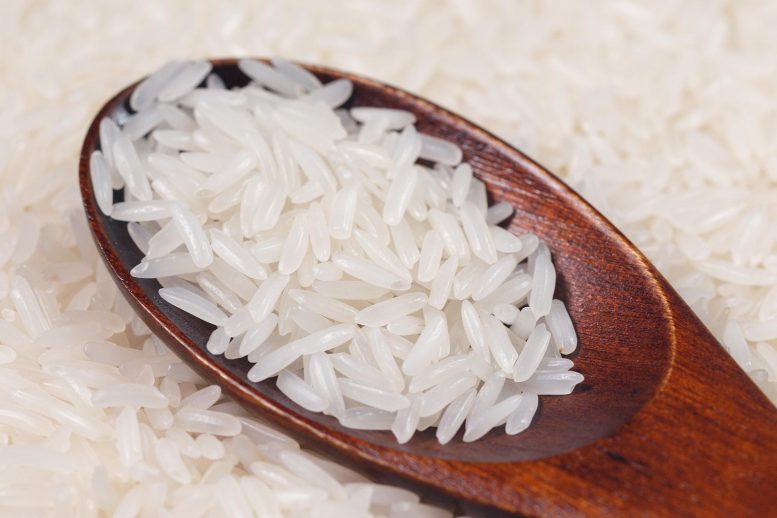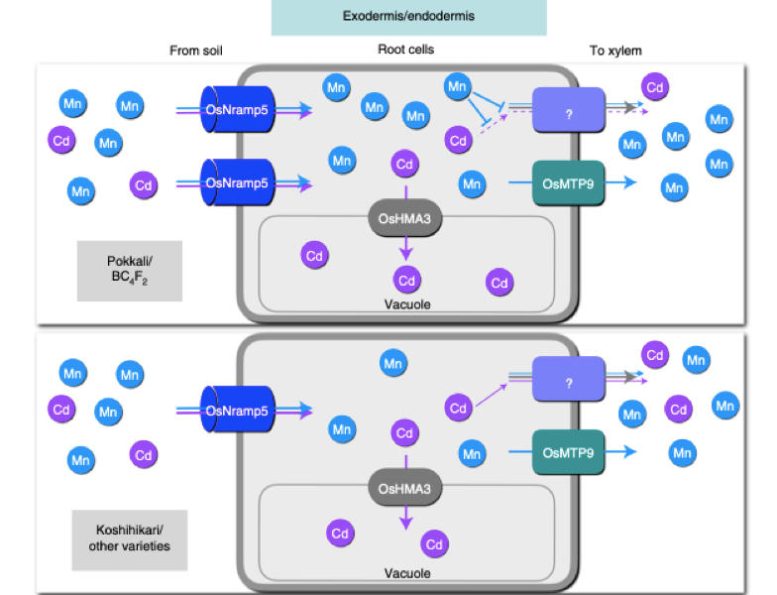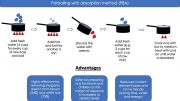
Using genetics to keep cadmium out of rice.
The duplication of a transporter gene reduces toxic cadmium accumulation in rice without harming quality or yield, according to the researchers.
Rice is a staple food for almost half of the world’s population. However, compared to other cereals like barley and wheat, it absorbs more cadmium from the soil. According to reports, rice accounts for 40–65% of our total dietary consumption of the toxic heavy metal cadmium. People who consume cadmium-contaminated rice face a significant danger to their health since excessive cadmium consumption is linked to conditions like Itai-itai disease.
Prior efforts have been made to lower the amount of cadmium in rice by importing clean soil, managing water, and combining contaminated soil with biochar and lime. These techniques, nevertheless, take a lot of time and money. To address this, scientists have used cross-breeding to cultivate rice that accumulates less cadmium.

In Pokkali, due to duplicated OsNramp5, the roots take up more Mn and Cd into the root cells compared with other rice varieties (for example, Koshihikari). Most Cd taken up through OsNramp5 is sequestered into vacuoles by OsHMA3, while most Mn is translocated to the shoots through OsMTP9. Higher Mn concentration in the root cells competes with Cd for an unidentified efflux transporter, resulting in decreased loading of Cd to the xylem and subsequently to the shoots and grains. The dotted arrow shows decreased Cd loading by high Mn. The cyan and purple colors indicate Mn and Cd, respectively. Credit: Jian Feng Ma, Okayama University
“We have been working on the mechanisms of cadmium accumulation in rice and barley for a long time and have identified several key genes involved in its accumulation,” says Professor Jian Feng Ma, who is affiliated with the Institute of Plant Sciences and Resources at Okayama University, Japan. Recently, Professor Ma recently published a paper in the journal Nature Food detailing the genetic mechanisms that play a role in this process.
Professor Ma and the members of his research team examined 132 accessions of rice and discovered that the gene OsNramp5, when duplicated in tandem, decreased the accumulation of cadmium in Pokkali, a type of rice cultivated for three thousand years in Kerala, India. OsNramp5 encodes a cadmium and manganese transporter protein in rice, according to earlier research. When the same gene is duplicated in tandem, it increases the absorption of both minerals into root cells. As a result, manganese and cadmium compete in the cells for translocation to the shoots, which in turn inhibits cadmium from building up in these regions.
The tandem duplication of OsNramp5 was discovered by the researchers to be naturally present in just one of the 132 rice accessions, Pokkali, which can grow in salty coastal soil.
The researchers also discovered that OsNramp5’s spatial expression level was consistently about two times greater in the roots of Pokkali than in Koshihikari.
As Pokkali stores extremely low cadmium in its shoots, the scientists introgressed (a term for the transfer of genetic information across species) the duplicated OsNramp5 gene in Koshihikari, a variety of rice that is very popular in Japan but accumulates relatively high levels of cadmium. Explaining how targeted breeding can help humans, Professor Ma says, “We identified a gene responsible for differential accumulation of cadmium in rice grain based on natural variations in cadmium accumulation. Then, we applied this gene to successfully breed rice cultivars with low cadmium accumulation in the grain.”
The team found that the Koshihikari cultivar with the duplicated gene accumulated significantly lower amounts of cadmium without comprising on the grain quality or yield.
Recounting the benefits of a low cadmium-accumulating rice variety, Professor Ma explains, “Cadmium is a toxic heavy metal and threatens our health through the food chain. Our study provided a useful material for breeding varieties of rice with low cadmium accumulation, which contributes to producing safe and healthy food. We hope that this gene will be widely used in breeding different rice cultivars with low cadmium accumulation. This will protect us from cadmium poisoning.”
Reference: “Duplication of a manganese/cadmium transporter gene reduces cadmium accumulation in rice grain” by En Yu, Wenguang Wang, Naoki Yamaji, Shuichi Fukuoka, Jing Che, Daisei Ueno, Tsuyu Ando, Fenglin Deng, Kiyosumi Hori, Masahiro Yano, Ren Fang Shen and Jian Feng Ma, 18 August 2022, Nature Food.
DOI: 10.1038/s43016-022-00569-w
The study was funded by the Japan Society for the Promotion of Science.









People in the East have been eating large quantities of rice with elevated cadmium AND arsenic for thousands of years. Is there evidence that this has been or is harmful? Is it possible that after thousands of years that there has been genetic selection for people who are cadmium and/or arsenic tolerant in that area of the world? Might the acceptable UK levels of heavy metal content in rice be arbitrary and more a function of detection levels than a threshold for demonstrated chronic pathology?
I really wonder about that, as well as so many other toxins. In the end, so many toxins have no damage-free level, so detectability becomes the de facto starting point for setting any limits. Given modern tech, many toxins (even some formerly non-toxins) will be assigned much lower limits, like the PFAS chemicals.
BTW, I was really hoping for a follow-up comment about arsenic-related gene manipulation. Perhaps my focus is on that simply because I have seen many more published articles concerning arsenic than cadmium. (To wit, my version of this current web page has a link about arsenic (https://scitechdaily.com/scientists-find-new-way-of-cooking-rice-that-removes-arsenic-and-retains-nutrients)!
Cadmium causes or increases cancers, bone softening (osteomalacia), bone pain and kidney stones. It is NOT recommended. The word ‘Itai’ means ‘It Hurts’.
https://www.atsdr.cdc.gov/csem/cadmium/Chronic-Effects.html
True, cadmium is not recommended, but it can also be said that mercury is NOT recommended. Despite that, there is a limit below which mercury intake is not considered a worthwhile concern by US gov’t doctors – one can of tuna per week So, is the mercury intake limit related to the levels at which it can detected? My suspicion is that the safety limit is often chosen by how easily one can meet the limit without political complaints from those negatively affected by the limit standards.